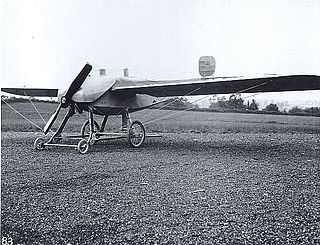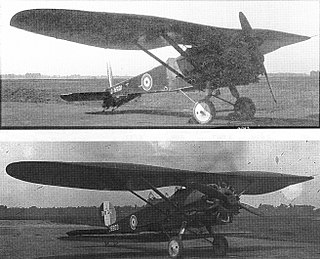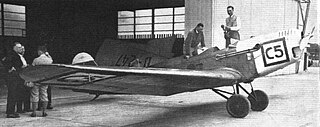Related Research Articles

Blackburn Aircraft Limited was a British aircraft manufacturer that concentrated mainly on naval and maritime aircraft during the first part of the 20th century.

A biplane is a fixed-wing aircraft with two main wings stacked one above the other. The first powered, controlled aeroplane to fly, the Wright Flyer, used a biplane wing arrangement, as did many aircraft in the early years of aviation. While a biplane wing structure has a structural advantage over a monoplane, it produces more drag than a monoplane wing. Improved structural techniques, better materials and higher speeds made the biplane configuration obsolete for most purposes by the late 1930s.
Auster Aircraft Limited was a British aircraft manufacturer from 1938 to 1961.

A monoplane is a fixed-wing aircraft configuration with a single main wing plane, in contrast to a biplane or other multiplane, which have multiple planes.

Junkers Flugzeug- und Motorenwerke AG more commonly Junkers[ˈjʊŋkɐs], was a major German aircraft and aircraft engine manufacturer. It produced some of the world's most innovative and best-known airplanes over the course of its fifty-plus year history in Dessau, Germany. It was founded there in 1895 by Hugo Junkers, initially manufacturing boilers and radiators. During World War I, and following the war, the company became famous for its pioneering all-metal aircraft. During World War II the company produced some of the most successful Luftwaffe planes, as well as piston and jet aircraft engines, albeit in the absence of its founder, who had been removed by the Nazis in 1934.

Nieuport, later Nieuport-Delage, was a French aeroplane company that primarily built racing aircraft before World War I and fighter aircraft during World War I and between the wars.

The Pitts Special is a series of light aerobatic biplanes designed by Curtis Pitts. It has accumulated many competition wins since its first flight in 1944. The Pitts biplanes dominated world aerobatic competition in the 1960s and 1970s and, even today, remain potent competition aircraft in the lower categories.
Sir W. G. Armstrong Whitworth Aircraft Company, or Armstrong Whitworth Aircraft, was a British aircraft manufacturer.

Escuadrilla de Alta Acrobacia Halcones, known simply as the 'Hawks' (Halcones), is an active group of nine officers of the Chilean Air Force who are trained specifically for aerobatics. One of the Halcones' signature moves is recreating the Chilean star in the air using smoke. The team may be likened to the British Royal Air Force's Red Arrows for their affinity for complex, high-risk, aviation-based manoeuvers.

Wayne Handley is an American airshow performer, former naval aviator, agricultural pilot, Aerobatic Competency Evaluator (ACE), and coach for upcoming and current airshow stars. Handley and his wife Karen are former residents of the Salinas Valley of California, who currently reside in Groveland, California.

Dart Aircraft Limited was a British aircraft manufacturer during the 1930s. Its facilities were located at 29 High Street North, Dunstable, Bedfordshire.

The Bristol Coanda Monoplanes were a series of monoplane trainers designed by the Romanian designer Henri Coandă for the British company British and Colonial Aeroplane Company.

The Bristol Bullfinch was an experimental British military aircraft first flown in 1922. Variants were built as both parasol wing monoplanes and biplanes, but both versions proved unsuccessful, and only the three prototypes were built.

The Blackburn C.A.15C Monoplane and Biplane were a pair of British aircraft intended to be as similar as possible apart from their wing arrangement. Tests in 1933 did not favour either design conclusively.

The Bristol Type 72 Racer was a British racing monoplane designed by Wilfrid Thomas Reid and built by the Bristol Aeroplane Company at Filton, England.
The Avro Burga was built by Avro for R.F. Burga to test his unique system of lateral control. It was a single-engined two-seat monoplane, fitted with differentially operated surfaces above and below the central fuselage.

The Klemm L 26, later Klemm Kl 26, was a low-wing trainer aircraft built by Klemm.
References
- ↑ Donald 1999, p. 682.
- ↑ Pitts Aircraft